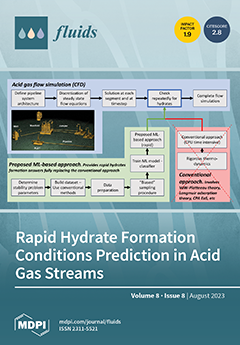An inverted bottle empties in a time
through a process called “glugging”, whereby gas and liquid compete at the neck (of diameter
). In contrast, an open-top container empties in a much shorter time
through
[...] Read more.
An inverted bottle empties in a time
through a process called “glugging”, whereby gas and liquid compete at the neck (of diameter
). In contrast, an open-top container empties in a much shorter time
through “jetting” due to the lack of gas–liquid competition. Experiments and theory demonstrate that, by introducing a perforation (diameter
), a bottle empties through glugging, jetting, or a combination of the two. For a certain range of
, the perforation increases the emptying time, and a particular value of
is associated with a maximum emptying time
. We show that the transition from jetting to glugging is initiated by the jet velocity reaching a low threshold, thereby allowing a slug of air entry into the neck that stops jetting and starts the glugging. Once initiated, the glugging proceeds as though there is no perforation. Experimental results covered a range of Eötvös numbers from
Eo∼ 20–200 (equivalent to a range of
4–15, where
is the capillary length). The phenomenon of bottle emptying with a perforation adds to the body of bottle literature, which has already considered the influence of shape, inclination, liquid properties, etc.
Full article





